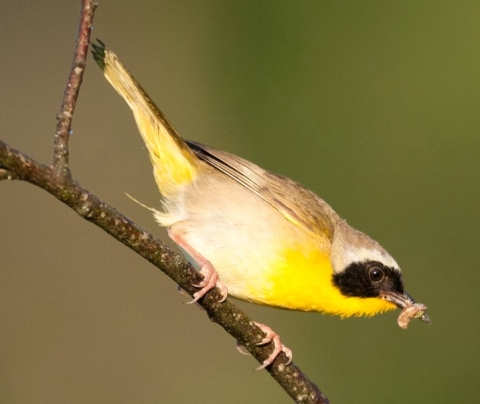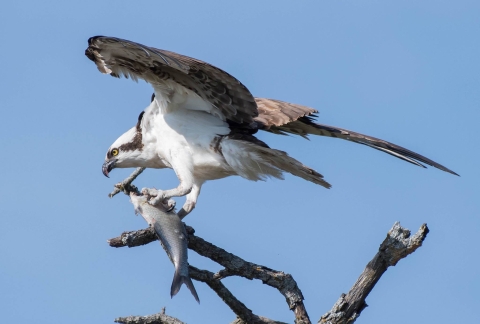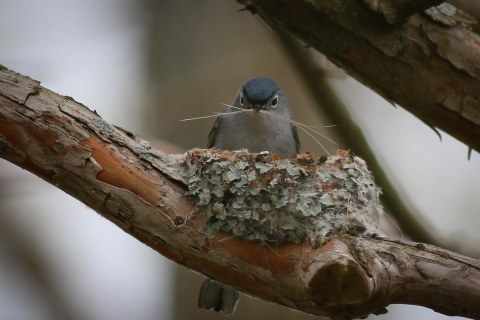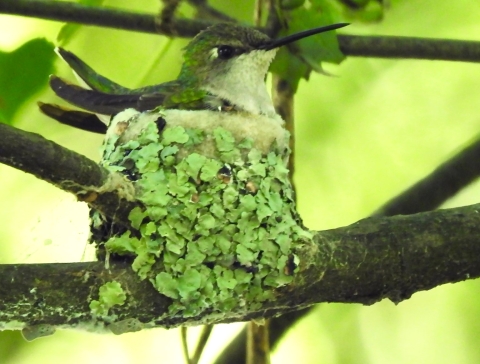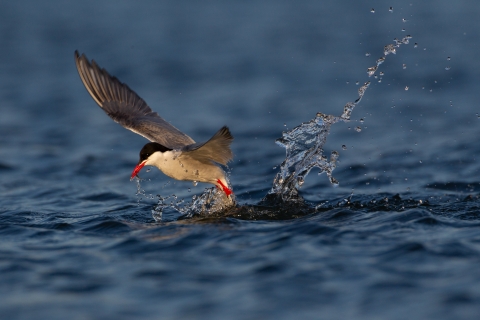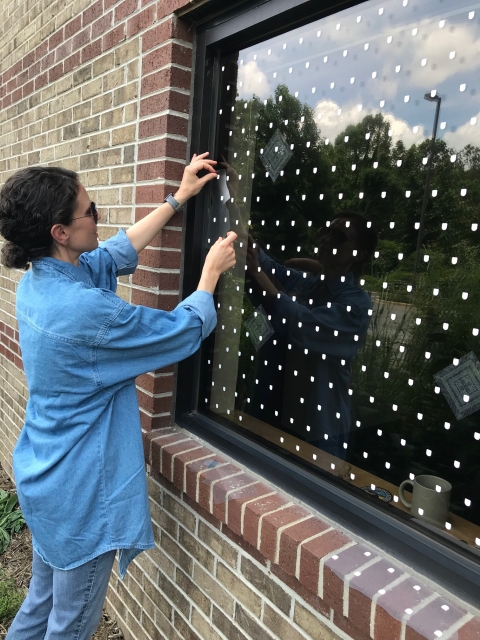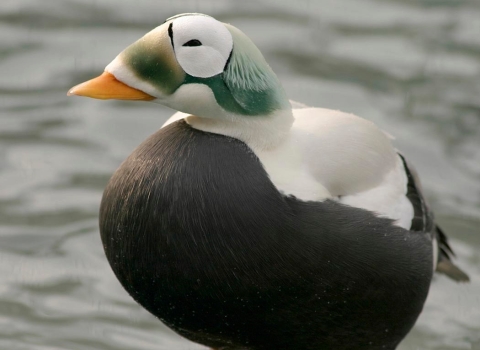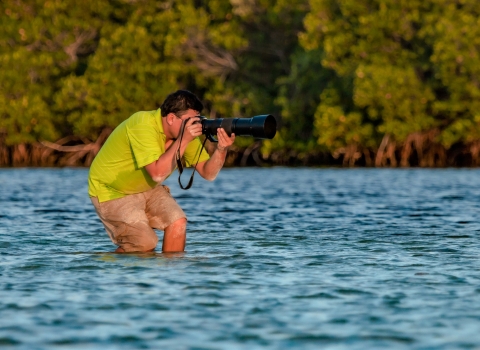Why Birds Migrate
The energy required for birds to fly long distances across mountains, oceans, and hemispheres is enormous, given their relatively small size. So, what motivates this strenuous effort?
While the factors influencing migration are varied, two primary motivators stand out: the quest for food and the need for suitable nesting habitat.
Food
Each species of bird has evolved over millions of years to eat certain foods. While most migratory songbirds eat seeds, berries, fruits, insects, aquatic invertebrates, grains, larvae, and buds, each individual species has a unique diet. As seasons change, many birds are motivated to migrate to warmer regions where these foods are still abundant, ensuring they have the energy to meet their needs throughout the year.
For example, the common yellowthroat is a migratory bird species that eats mostly insects, including grasshoppers, dragonflies, beetles, moths, caterpillars, and spiders. That means it needs to follow the type of temperature where the insect populations are booming. There are also birds called aerial insectivores that eat insects on the wing – meaning they eat insects as they fly around in the air. Chimney swifts are a type of aerial insectivore that dine exclusively on flying insects, eating one-third of their body weight, or about 1000 flying insects, every day! Species like these need insects to be available to survive. Yet, as summer turns to fall and fall turns to winter, plants and insects become less and less available, triggering birds like these to migrate where the insects are by following flyways to temperatures where they are booming!
Other species, like American goldfinches, pine siskins, and common redpolls eat mostly seeds. These birds forage in trees, shrubs, grasses and weeds with beaks uniquely evolved to crack open seeds. Pine siskins can even store seeds in their crop (part of their esophagus) to help get them through the cold winter nights, and redpolls have a throat pouch where they can store seeds for a short time. Now those are special adaptations for their food sources!
Then there are those migratory species that are predators, like raptors such as broad-winged hawks and Cooper’s hawks. They too need to follow their food sources! If their prey is on the move to find food (including other birds like the species we just mentioned!) then they must migrate as well. When water temperatures begin to cool and fish move to warmer waters, so too does the Osprey begin its annual migration to find ample food supplies.
NESTING
Migrating for food goes hand-in-hand (or in this case, wing-in-wing) with another major reason birds migrate: nesting. Birds migrate to find a mate, make a nest, lay their eggs, and raise their young where there are ample resources to support them. Breeding and nesting are the most important things birds do from a biological and evolutionary perspective, and they need a lot of resources to do it successfully.
As a neotropical migratory bird species, many blue-gray gnatcatchers migrate from their nonbreeding grounds in the tropics of Central America to the forests and wooded habitats across the U.S. Males and females will jointly choose a safe place to make their nest and then build it together. What's really interesting about their cup-like nest is that it is just 2-3 inches wide and they keep the materials connected with spider webs or caterpillar silk. Wow! They are even known to attach lichen, hair, or pieces of bark to the outside of the spider webbing, like decorations. And even after all that work, they build several nests during the season in order to deal with predators, mites, or cowbird parasitism. They usually have 3-5 eggs in each clutch and will ideally have 2 clutches per season. This means the parents are constantly working on building their nests, hatching chicks, working to feed all those chicks and fledge them from the nest during the breeding season. And on top of all that, they need to have enough energy to somehow start their migration journey back to their nonbreeding grounds where they will spend most of their year. Sounds exhausting!
Ruby-throated hummingbirds also make a tiny cup-like nest with similar materials. However, they differ in that the male ruby-throat hummingbirds leave their wintering grounds in Central America a few weeks before the females. After courting and mating in their breeding grounds across eastern North America, the males leave the nest and live a mostly solitary, territorial life, fending for themselves the rest of the season. Scientists believe this may be to avoid competing for the same resources with the females and chicks. Females will then build their incredibly small nests (only 2 inches wide!) in the branches of deciduous trees, ideally producing 1-3 eggs from 2 clutches over the course of the breeding season. Like other hummingbird species, ruby-throated hummingbirds co-evolved with many plants and time their migration to coincide with when native plants at their destination are blooming. This way, the birds benefit from having food and nest resources while the plants benefit from the pollination that happens as they gather nectar. Females will feed their chicks both nectar and insects, which are mostly found during the warm seasons, but too fade away when the weather turns colder. That’s when they begin their migration back to South America where they will continue to experience warm weather and find the food and resources they need.
In many bird species, migration isn't a one-size-fits-all behavior. This is particularly true for 'partial migrants,' species with some birds that migrate and others that stay in the same place all year.
For example, the wood stork (North America’s only native stork!) is considered a partial migrant because only the juveniles fly north after nesting season while adults move in response to food ability. These large wading birds mate with the same bird for life, and build their nests together in cypress swamps and mangroves. Their large nests are usually built from sticks and greenery in trees above water to provide a barrier from ground predators, such as racoons and snakes. Each year, the pair return to the same nest, with the males usually arriving a few days before the female to repair and enlarge the structure. Their movement throughout the year can also be in response to rainfall patterns which can impact the safety of their nest and food availability.
Some birds don’t migrate at all, some migrate short distances, and others migrate over really long-distances. In fact, the arctic tern has the longest migration of any bird in the world! It travels between the Arctic circle and the Antarctic every year – more than 55,000 miles from pole to pole. Amazing!
What do birds need to make the journey?
Migration can be affected by day length, weather, the local environment, food availability, geography, topography, and other factors. When you think about all those factors that can affect when a bird decides to migrate, it’s almost overwhelming.
Imagine you were an arctic tern about to make that long journey across the world, what would you need?
If you said habitat, you’re right!
Birds, like the Arctic tern, need safe places to rest and refuel with food and water during their migration. Some species need wetlands, others need forests, grasslands, or meadows, and some need shorelines as they follow the coasts along oceans. Each bird uses different habitats, so it’s important that there are lots of different habitats on the landscape that they can use. Biologists refer to these places as “stopover” habitats, areas where birds stop to rest, eat, and seek shelter from predators. Some stopover sites are so large they can even be called “staging areas” because so many birds come together to rest and then continue their migration.
For example, one of the most famous staging areas around the world is along the Platte River in central Nebraska, where more than 500,000 sandhill cranes gather in a spectacle of migration! The Platte and other shallow water wetlands provide places to rest and refuel while offering protection from predators or migration hazards. They feast on kernels of corn from the cornfields that surround the river, along with some invertebrates like worms and snails. But it’s not just sandhill cranes that use the area. The shallowness of the central Platte River and flat valley around it also makes it an incredibly important area for millions of other migratory birds including geese, ducks, songbirds and even threatened and endangered species such as piping plovers, interior least terns and whooping cranes.
What are migration hazards birds face?
If you were a bird, migration would be the most dangerous time of your life. You are at your most vulnerable. You spend a lot of energy flying over large expanses of land, continents even, constantly searching for safe habitats to rest refuel, all while trying to avoid hitting structures, bad weather, and predators along the way. Sadly, each year billions of birds do not survive.
Imagine a landscape that was full of trees, grasslands, wetlands, and mountains. The skies were dark with starry skies like a map for birds to navigate their way throughout the night.
Today, many of those natural habitats on the landscape have been replaced with human-made structures, like buildings and homes. This loss of habitat alone is a threat to birds as they must expend more energy looking for safe areas to rest, eat, and carry out their journey. Plus, now the lights from homes, communities, and cities, spills into what used to be a dark, starry night sky. Unfortunately, these lights at night can cause confuse birds, directly impacting their ability to migrate. This confusion not only makes it harder for birds to find their way, but also increases some of their other threats. For example, birds disoriented by lights at night tend to circle structures for extended periods of time, depleting the energy they stored for migration, often leading to collisions with the structures as well.
Collision hazards for birds come in many forms and can affect many types of birds. In fact, nearly one billion birds collide with glass in the U.S. alone each year. Most of these (preventable) fatalities happen at homes and buildings shorter than four stories tall, though even aircrafts, towers, and smaller structures like glass walkways and bus stop shelters cause bird collisions too.
Why is that? Because birds can’t see glass as a barrier the way we do, so they don’t avoid it. Sometimes, birds collide with windows when our lights from indoor spills through and attracts them in. Other times, they collide with glass when they see natural reflections, like clouds and trees, or plants through windows. Even lights used for streets, landscaping, and offshore structures can attract and disorient birds and lead to fatal collisions.
Beyond light pollution and collisions, birds also face growing threats of bad weather events during their migration. Navigating through fog and finding shelter during storms, wind and other unpredictable types of weather can really affect birds throughout their journey.
And then there is the threat of predators. During migration, many birds will not know what predators they might face at stopover sites or even when they reach their destination. Whether their predators are humans, snakes, racoons, foxes, or even other birds along the way, these travelers must constantly be on high-alert.
Migration is full of uncertain times for birds. They need all the energy they can gain just to migrate during good weather, so the combination of habitat loss, light pollution, obstacles and barriers, bad weather, and predators, can become too much for many to handle.
What Can You Do to Help?
Turn off your lights! It’s really easy to turn off or dim our lights at night during peak migration season. If you can’t turn off all lights, consider turning off or dimming exterior lights – the flood lights that face up into the sky, roof-top lights that illuminate the surrounding landscape, or set motion-sensored lights to only be active when people are present.
We can also use blinds, shades, awnings and shutters to reduce the amount of interior light that escapes outside and help birds see the glass as a barrier. By reducing lights, we not only help birds (and other impacted wildlife), but we also help the environment by reducing energy use, and help ourselves by reducing costs and minimizing light pollution to restore starry night skies!
You can also have fun dressing up your windows to help prevent bird collisions. By applying paint, patterns, decals, screens, netting, or any of the window treatments mentioned above, you can make your windows easily seen by birds all while being creative at the same time! Just make sure your window patterns are 2-inches apart and on the outside of glass. Window patterns spaced too far apart don’t prevent bird collisions.
Another action we can take (with benefits beyond the birds!) is minimizing pollution from reducing, reusing, and recycling to prevent plastics and other materials from deteriorating habitats. Birds (and other wildlife) can become injured, poisoned and even starve from accidentally eating these materials when they are mistaken for food.
Consider providing or restoring bird-friendly habitat by planting or maintaining native trees, shrubs, grasses, and flowers. Even simple actions like leaving leaf litter and fallen branches on the ground can create natural foraging opportunities and provide cover from predators. This vegetation can provide essential food sources, offer shelter, and nesting sites for a wide variety of species, including pollinators and other beneficial insects' birds eat! It can also be helpful to minimize use of pesticides and herbicides, which can kill insects and the plants that many types of birds and other wildlife rely on for food.
But don’t stop there! Consider becoming a citizen scientist by reporting species you see using free tools like eBird, iNaturalist, Project Feeder Watch, or by participating in international birding events like the Christmas Bird Count. Take it a step further and purchase a Duck Stamp or participate in either our National Duck Stamp or Junior Duck Stamp contests! Sales from Duck Stamps go towards conserving important wetland habitats that birds need for resting and refueling during migration.
Wing-to-wing, the more actions we all take, the more impact we all make!
Learn how you can help prevent bird collisions with our Bird Collision Prevention Toolkits!

